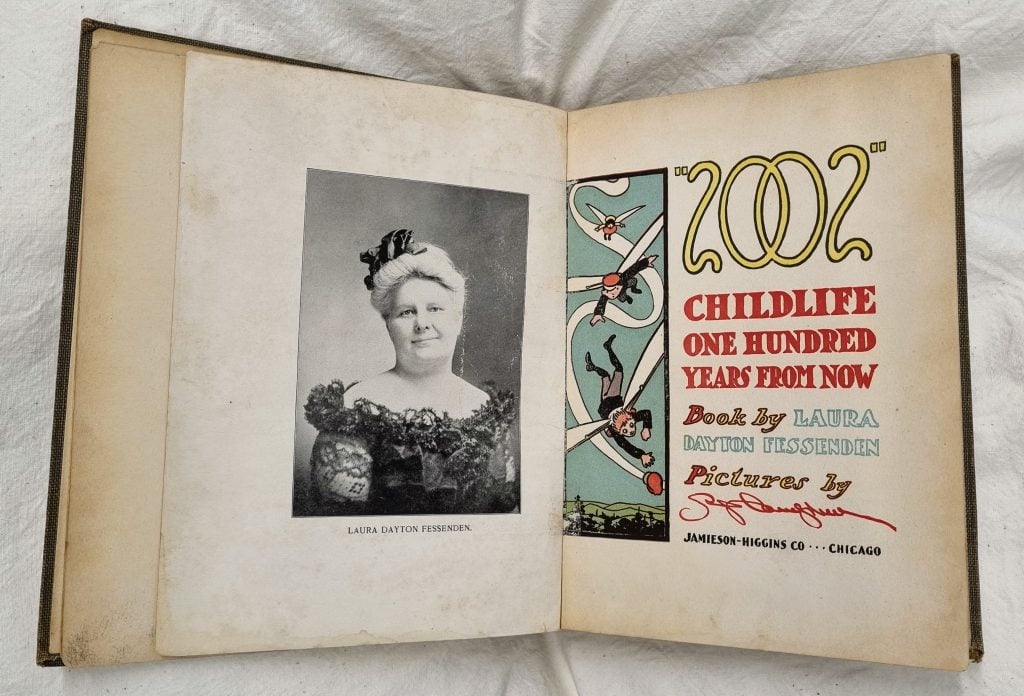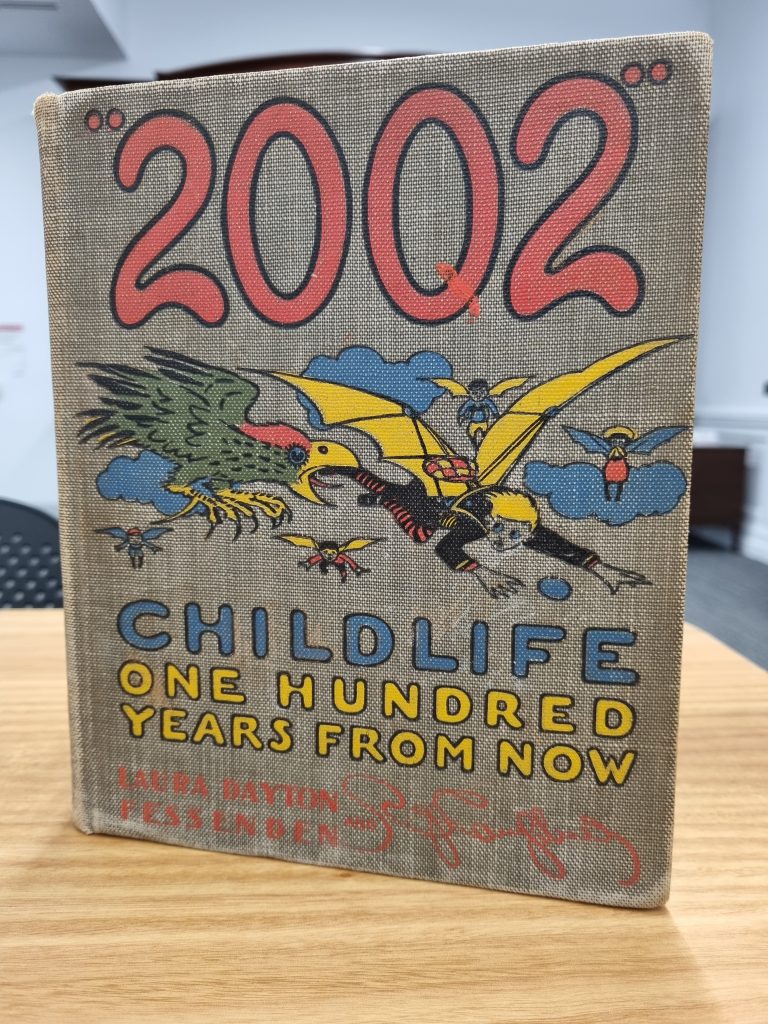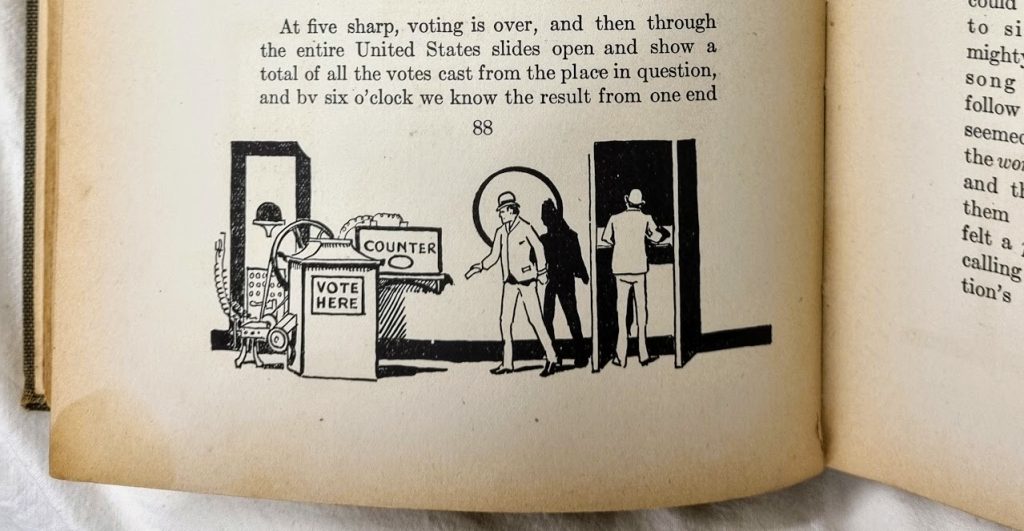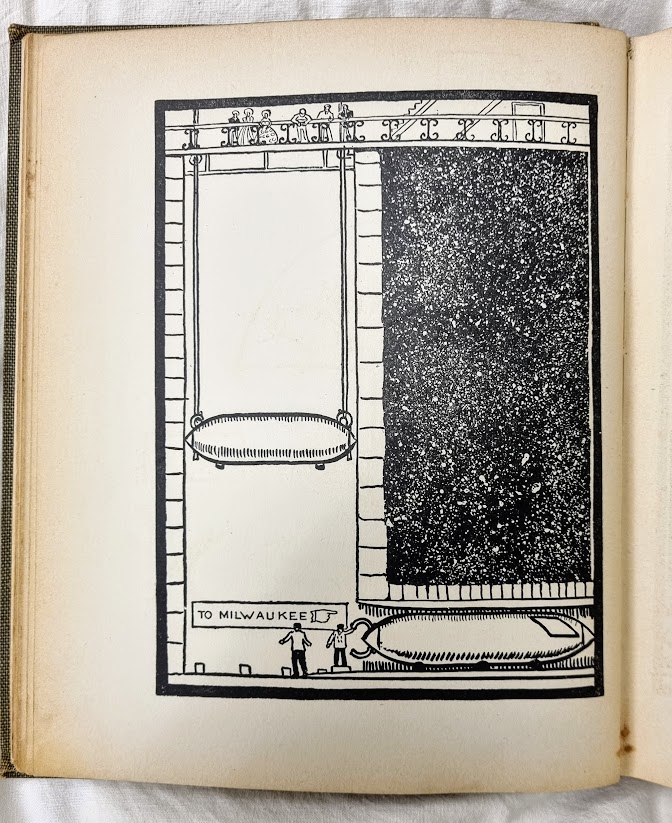If someone had asked me in 1989 what the future would look like in the year 2002, I would have pointed to important technological advancements like hoverboards, automatic tie-up shoes, self-drying jackets, and flying cars. Yes, I was a huge Back to the future fan. In reality, 2002 brought us Star wars: episode II – attack of the clones, Von Dutch, and the release of the compact off-road vehicle, the Holden Cruze. Take a long hard look at yourself, 2002.
One hundred years earlier, American author, Laura Dayton Fessenden published a children’s science fiction novel that answered just that question. 2002: childlife one hundred years from now explores in fantastical detail, a utopian and technologically savvy society.
In 1852, Laura Canfield Spencer Dayton was born into an affluent and well-educated New York family, describing her childhood memories as full and overflowing with peace and happiness.1 Little has been written about Laura Dayton Fessenden’s life; a 1902 family biography written by Fessenden points to a modest and self-deprecating character, who wrote for fun. She writes, “Realizing with Mrs. Browning (Elizabeth Barrett Browning), that all the birds will sing, I have never felt impelled to quench the spark of literary impulse that longs to express itself; not so much that any may hear, as to have the personal joy of writing, so I have written some books that have been published and some songs that have been sung.”2 In fact, Fessenden’s bibliography makes for impressive reading, including titles such as Essie: a romance in rhyme, A puritan lover, Songs that the children sing, and The white witch of Salem Town.
It is with delight that this librarian found a reference to Elizabeth Barrett Browning’s epic poem ‘Aurora Leigh’, as the Library was fortunate to have recently acquired the first edition of Browning’s critical work An essay on mind: with other poems, thanks to the Women Writers Fund. Our fortuity continued some weeks later when the Women Writers Fund acquired Laura Dayton Fessenden’s most fascinating work of speculative fiction, 2002: childlife one hundred years from now.

The novel follows the main protagonist Pollie, who lives in a vegetarian and social utopia that has enjoyed “Perpetual Peace” since 1980. In Fessenden’s 2002, America overwhelmingly votes for a woman president through computerised voting machines and video telephones.
“Jane Addams is elected by an overwhelming majority; she comes of a very illustrious family, her great great Aunt stood high in the love and honor of her countrymen more than a hundred years ago.”
People use a variety of personal and commercial transportation, including airships, individual sets of flying wings, submarines, and giant pneumatic tube steel coaches.
“This hall was divided by tall iron fences into different roads paved with spotless white marble. At the end of each of these roads was an opening where an escalator or moving stairway led up and down to and from the in-coming and departing trains. Down one of these stairways went the boys, and there on the track stood the train – and by the train is simply meant the cars for there was no engine or motor to be seen. These cars were about fifty feet long and shaped like a cylinder standing on a lot of little feet, and these queer looking passenger coaches had not a single window.”
Fessenden explores Charles Darwin’s ideas around evolution by natural selection; an exploration that results in the employment of apes and monkeys as servants. In 2002 we are introduced to Juanita, the Chimpanzee scullery maid:
In 2002 citizens have done away with textiles, replacing them with robust paper that was made by the Government in large factories.
“Long, long ago, the old style of dressing and of materials, had gone out of fashion, and now, all garments save shoes were made of a sort of paper, warranted not to tear, or to burn, yet the material was soft and flexible enough to be pleated, or tucked, or gored.”
“The charges were so nominal, that the poor as well as the rich, were always well clothed-and as it had come to be considered an evidence of a sick mind, to wear gaudy apparel or gold or jewel, men, women and children in the year of our Lord, “Two Thousand and Two,” were sensibly, comfortably and neatly dressed.”
Perhaps Fessenden’s most astounding and contemporaneous speculations centered around renewable energies and the consumption of energy by humans.

“I will try to tell you in simple language what this world of ours has accomplished in a century of time, for it has made captive Nature’s three greatest forces in controlling, and using the power of the ocean wave, the sun’s energy, and the earth’s magnetism. And first we will talk about electricity. Would you believe it my dear, when I tell you, that one hundred years ago they did not deliver Electricity to our houses, our offices, our public buildings as they do now?“
“Just fancy, they used crude coals for heating purposes, and then dispersed the heat about, through things that they called stoves, registers and radiators, and this heat, generated as I have said, from smoky, dusty coal.”
Thanks to the Women Writers Fund, important and interesting works like Laura Dayton Fessenden’s 2002: childlife one hundred years from now are being acquired for the State Collection.
The Women Writers Fund is a pioneering new initiative that seeks to redress the State Library Victoria’s collection by acquiring works by under-represented women writers. The work of the Women Writers Fund will give future generations access to more diverse and representative voices from different times, cultures, and disciplines.
If you would like to contribute to this ground-breaking initiative you can make a donation to support the Women Writers Fund.
- Fessenden, L. D. (1902). Genealogical Story (Dayton and Tomlinson). Crist, Scott & Parshall.
- Fessenden, L. D. (1902). Genealogical Story (Dayton and Tomlinson). Crist, Scott & Parshall.









can you subscribe to an alert for the blogs?
Hi Amanda. It is possible but not an entirely intuitive process. You will need to download an install an extension: https://chrome.google.com/webstore/detail/rss-feed-reader/pnjaodmkngahhkoihejjehlcdlnohgmp?hl=en
From there you can put in the URL for SLV blogs and you will receive an alert when new content is posted.
Cheers